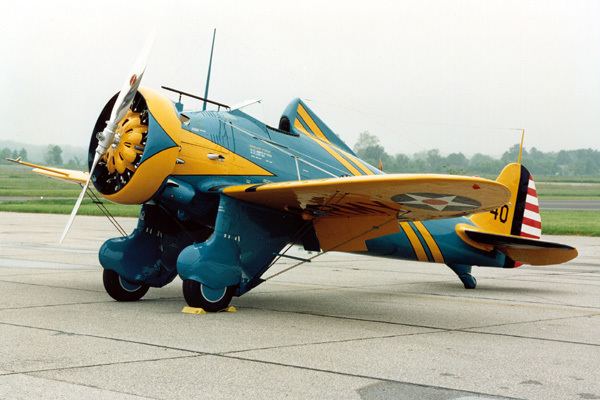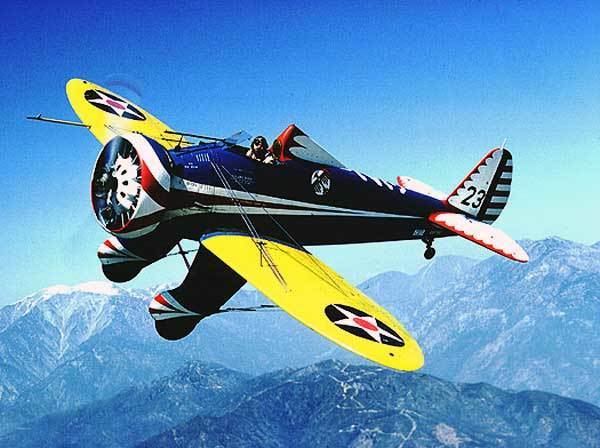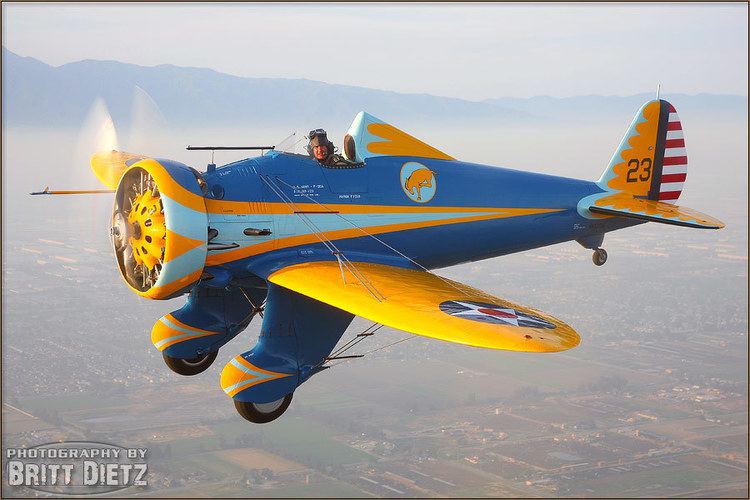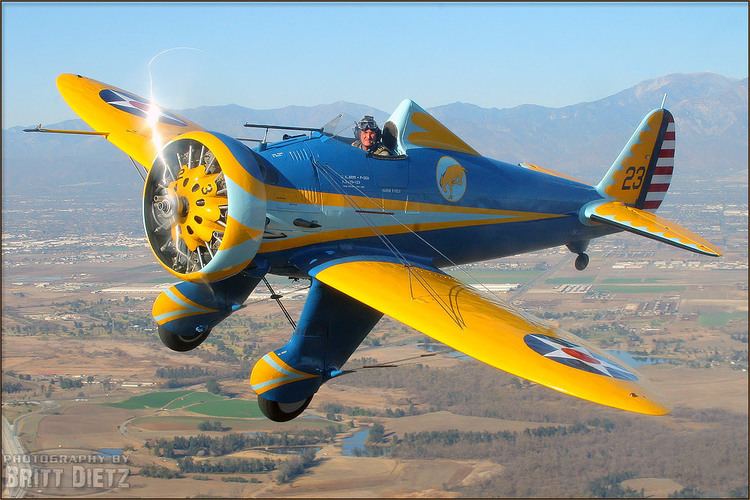Top speed 377 km/h Length 7.19 m Unit cost 14,009–14,009 USD | Range 1,020 km Wingspan 8.5 m First flight March 20, 1932 | |
 | ||
Engine type Pratt & Whitney R-1340 Wasp Similar Republic P 47 Thunderbolt, Curtiss P 40 Warhawk, Curtiss P 36 Hawk | ||
The Boeing P-26 "Peashooter" was the first American all-metal production fighter aircraft and the first pursuit monoplane to enter squadron service with the United States Army Air Corps. Designed and built by Boeing, the prototype first flew in 1932, and the type was still in use with the U.S. Army Air Corps as late as 1941 in the Philippines. There are only two surviving Peashooters, but there are three reproductions on exhibit with two more under construction.
Contents
- Boeing p 26 peashooter maiden
- Design and development
- US Army Air Corps
- Overseas deployments
- Combat service
- Variants
- Operators
- Surviving aircraft
- Replicas
- Specifications P 26A
- References

Boeing p 26 peashooter maiden
Design and development

The project, funded by Boeing, to produce the Boeing Model 248 began in September 1931, with the Army Air Corps supplying the engines and the instruments. The design, which included an open cockpit, fixed landing gear and externally braced wings, was the last such design procured by the USAAC as a fighter aircraft. The Model 248 had a high landing speed, which caused a number of accidents. To remedy this, flaps were fitted to reduce the landing speed. The Army Air Corps ordered three prototypes, designated XP-936, with the first flight on 20 March 1932.

The Boeing XP-936 was still tricky to land; sometimes, because of the short nose, it tended to roll onto its back and would flip forward, injuring a number of pilots. The prototype's unarmored headrest offered virtually no protection in such instances. As a result, production Model 266s ("P-26A"s) had a taller, armored headrest installed.

Two fighters were completed as the "P-26B" with a fuel-injected Pratt & Whitney R-1340-33 engine. These were followed by 23 "P-26C"s, with carburated R-1340-33s and modified fuel systems. Both the Spanish Air Force (one aircraft) and the Republic of China Air Force (eleven aircraft) ordered examples of the Model 281 version of the P-26C in 1936.

The diminutive "peashooter", as it was affectionately known by service pilots, was faster than previous American combat aircraft. Nonetheless, rapid progress in aviation led to it quickly becoming an anachronism, with wire-braced wings, fixed landing gear and open cockpit. The stressed-skin cantilever wing Dewoitine D.500 flew the same year as the P-26 and two years afterwards the Soviet I-16 was flying with retractable landing gear. By 1935, just three years after the P-26, the Curtiss P-36, Messerschmitt Bf 109 and Hawker Hurricane were all flying with enclosed cockpits, retractable landing gear and cantilever wings. However, the P-26 was easy to fly, and would remain in service until the U.S. entered World War II.
U.S. Army Air Corps

Deliveries to USAAC pursuit squadrons began in December 1933 with the last production aircraft in the series coming off the assembly line in 1936, designated the P-26C. Ultimately, 22 squadrons flew the Peashooter, with peak service being six squadrons in 1936. P-26s were the frontline fighters of the USAAC until 1938, when Seversky P-35s and Curtiss P-36s began to replace the P-26. A total of 20 P-26s were lost in accidents between 1934 and America's entry into World War II, but only five before 1940.
Air Corps units using the P-26 were the:
Overseas deployments
Between 1938 and 1940, P-26s were assigned overseas to supplement Seversky P-35s in two defense units based at Wheeler Field, Territory of Hawaii:
The 17th PG became the 17th Attack Group in 1935, and its P-26s were transferred in 1938 to the 16th Pursuit Group (24th, 29th, and 78th PS) at Albrook Field in the Panama Canal Zone. These P-26s were transferred in 1940 to the 37th Pursuit Group (28th, 30th, and 31st PS) which flew them until they were replaced by P-40s in May 1941. Some continued service with the 32d Pursuit Group (51st and 53rd PS), but only nine P-26s remained operational in Central America at the start of World War II.
P-26As were also flown by the 3rd PS of the 4th Composite Group, based in the Philippines. Between 1937 and 1941, 31 were sold to the fledgling Philippine Army Air Corps.
Combat service
The first Boeing P-26 to experience major combat operation was the Chinese Model 281. On 15 August 1937, eight P-26/281s from the Chinese Nationalist Air Force 3rd Pursuit Group, 17th Squadron, based at Chuyung airfield, engaged eight out of 20 Mitsubishi G3M Nell medium bombers from the Kisarazu Air Group sent to attack Nanking. The Chinese Boeing fighters helped shoot down two of the four Japanese bombers destroyed that day without suffering any losses. Subsequent engagements between the Chinese Peashooter pilots and pilots of the Imperial Japanese Navy flying the Mitsubishi A5M "Claudes" were the first aerial dogfights and kills between all-metal monoplane fighter aircraft. A single P-26 was in service with the Spanish Republican Air Force during the Spanish Civil War of 1936–1939, but no aerial kills were recorded with this fighter aircraft. It was shot down in 1936.
By December 1941, U.S. fighter strength in the Philippines included 28 P-26s, 12 of which were operational with the 6th Pursuit Squadron of the Philippine Army Air Corps. Filipino-flown P-26s claimed one G3M and two or three Mitsubishi A6M2 Zeros before the last of the P-26s were burned by their crews on 24 December 1941. The pilot's name was Jesús A. Villamor.
Only nine P-26s remained airworthy, serving in the Panama Canal Zone. In 1942–43, the Fuerza Aérea de Guatemala acquired seven P-26s ostensibly by the U.S. government smuggling them in as "Boeing PT-26A" trainers to get around restrictions of sales to Latin American countries. The last two P-26s in service were still flying with Guatemala's Air Force until 1956, when they were replaced with P-51 Mustangs. The P-26's last combat operation was with the Guatemalan Air Force during a coup in 1954.
The P-26 was the last Boeing Company fighter aircraft to enter service until Boeing acquired McDonnell-Douglas with production and continuing support contracts for the Boeing F/A-18E/F Super Hornet in 2002. Between those aircraft, Boeing did produce the prototype XF8B in 1944, as well as the X-32 entry in the Joint Strike Fighter contest in 2000.
Variants
Operators
Surviving aircraft
Replicas
Specifications (P-26A)
Data from Aviation-history.com
General characteristics
Performance
Armament
